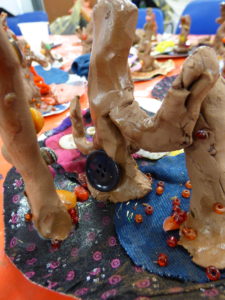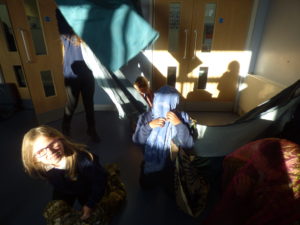For the 2019 Story Makers Project, the young people kept a weekly diary of how the project developed over the 12 weeks. You can read their journey below.
Story Makers, a participatory arts approach
Story Makers, conceived in 2010, is a partnership between Helen Edwards and Fusion Arts. In Story Makers, everyone is treated as an artist and creates new work alongside each other, sharing and trying out their own new ideas. Stepping out of traditional educational roles encourages children and adults to have new experiences of themselves and of relating differently in a learning group. Since it's creation, we have partnered with The Ashmolean, The Pitt Rivers Museum, The Oxford University History of Science Museum, The Natural History Museum and the Oxford Botanic Gardens.
Week 1
Groups met together for the first time, to get to know each other and find out about Story Makers project, we made artists cards to help us discover the artist within and to introduce ourselves to each other. We thought about how artists create and some of the qualities of curiosity and experimentation, as well as sharing and developing new ideas in colourful and sculptural non verbal means. We explored balance and connection with the ground, making imprints of our feet in clay, onto which we planted carefully designed seeds of clay.
Week 2
Week 3
Week 4
Week 5
Week 6
Week 7
We started to think about the relationships between humans and plants, how humans use plants and how plants use humans. We had so many ideas about water, oxygen, carbon dioxide, water, nourishment, survival, pollinating, movement, planting and growing, clothes, travel, housing, rest, germination, time and play. We made seeds out of wool, using our hands to wrap the wool around and make pom poms. We wondered if wearing lots of plant fibres and eating lots of plant makes humans into plants. We planted our newly made sometimes multicoloured seeds in the giant seed beds we are making and made trails of wool wondering if seeds can communicate with each other underground

Week 8


Week 9
Using printing techniques we made beautiful clay imprints of seeds and leaves from the Botanic Garden and also cyanotype prints of unusual design. We thought about the imprint the garden visit had made on us, and carried on writing our stories we add to each week, using the imaginative and sensory ideas we are learning to translate and integrate into life skills, growing confidence and communication.
Week 10
Adding more ideas to our stories, we thought about how we can bring new ideas into the world, like seeds growing into blossoming flowers, and keep them alive. We began to build 3D sculptures using hazel and willow weaving wool textures and colours into their sculptural forms to become flower heads and leaves, echoing some of the will sculptures we had seen in the Botanic Garden.


Week 11
Revisiting some of the movement activities from earlier in the project, we used our bodies to remember how we had imaginatively explored growing up towards the sun from seed, individually and then joined by our hands together as a group, and the differences and similarities we felt. This helped us consider how we wanted to develop the growth of our unique flower sculptures, adding modroc and more leaves to give them more strength.

Week 12
In our final sessions all participants received books of their stories and photographs from the sessions, full of memories and ideas. We reflected on what we had enjoyed about Story Makers and shared how we felt about the ending. Everyone read their stories with great expression to a group of eager listeners. Then we made glass gardens together, using beautiful coloured glass and glass paints to weave together what we had learnt about artists responding to gardens.
Find out more about the Story Makers Project.






















